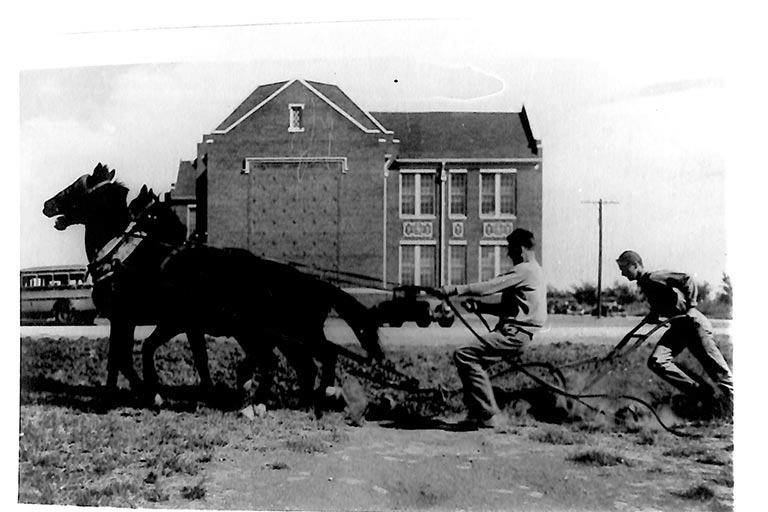"The Golden Years: 1928-1960," authored by Dr. Floyd Golden, the late second president of Eastern New Mexico University, details the years preceding the 1934 opening of Eastern through 1960.
Chapter 3
"The Junior College Years"
Before its 1934 opening, Dr. Floyd Golden was convinced Eastern New Mexico Normal School was convinced that the name should be changed. In his travels throughout the state, there was much opposition to opening another normal school. When he asked the state's residents how they felt about a two-year junior college instead, their response was overwhelmingly favorable.
The Board of Regents soon agreed to change the name of the school to Eastern New Mexico Junior College. The next task was finding a president.
After contacting several candidates, and being rejected by them, Donald W. MacKay, Rural School Supervisor for the New Mexico Department of Education, was interviewed by the Board of Regents. After learning about MacKay, the president of the University of New Mexico tried to get the Board to interview one of his professors for the position. But, after determining he may have actually wanted to ensure the school's failure. The position was offered to MacKay.
Dr. Golden, superintendent of Portales Schools, was given permission to work half-time as "dean" of the college for the first year. After that year, he chose to work at Eastern full-time.
MacKay's salary for May 1934 was $300, $360 for June and $4,500 for the fiscal year beginning on July 1.
Dr. Golden's salary for the first year was $3,600, with the Portales schools providing $1,500 of that amount.
After these two hires, the Board of Regents has $57,129.30 to operate a summer session in 1934 and the regular 1934-35 academic year.
Fifteen faculty were hired for the six-week summer session. The campus consisted of 43 acres and the first unit of the Administration Building was renovated and completed after sitting in disrepair for several years.
In addition, a small farmhouse was remodeled and converted into a music cottage. From time to time in the coming years, classrooms, practice rooms and a concert hall were added.
The campus was partially landscaped with Chinese elms, shrubbery, grass, sidewalks, curbs, gutters and caliched streets and driveways.
The first registration was conducted on June 2, 1934, and an unexpectedly high number of 165 students registered. During the evening, a musical concert on the courthouse square was dedicated to Eastern New Mexico Junior College.
On the evening of June 5, an all-college assembly was held in the Methodist Church where President MacKay spoke on "The Challenges of our College."
During the summer session trips were planned every weekend for the students to various parts of New Mexico, Colorado, Texas or Arizona. Recreational activities, music programs and a picnic were held each week on campus.
Enrollment for the first regular academic year also exceeded expectations with 299 students enrolling.
"President MacKay was fully aware of the pressing need for an outstanding faculty if the Junior College were to be a success," Dr. Golden wrote.
Of the 18 faculty and administrators for the first full year, four had Ph.D.s.
Dr. Golden served Eastern as dean and later as president until his 1961 retirement.
The first year the school offered 136 courses in the Administration Building which had only nine classrooms, a science room, a home3 economics room, a commercial room, an art room, a library and administrative offices.
Some periods in the day armchairs had to be moved from one classroom to another. The students knew when and where to move the chairs so they would have a place to sit.
In 1939-40 enrollment had increased to 729 students, the faculty numbered 30 and courses had increased to 242.
The highlight of the first academic year was the inauguration of Dr. Donald William MacKay as the first president at 10:30 a.m. on Oct. 6, 1934. Since no facility large enough was available on campus, the ceremony was held at the Methodist Church. At noon the Portales Chamber of Commerce served a huge barbecue to visitors and guests. This was followed by a parade through the community that ended just before the first-ever football game at 2 p.m.
The Greyhounds, coached by D. H. "Tiny" Reed, played against the freshmen of New Mexico A&M. ("The Golden Years" does not mention the score, but the team had no losses and two ties their first year.)
The Greyhound mascot for the athletic teams had been chosen on Tuesday morning before the game. The entire student body and faculty met in the Methodist Church where they selected a mascot, the college colors of silver and green and the name "The Chase" for the college newspaper.
The school held its first homecoming in 1935.
In the early years, Eastern offered a chance for students to take summer tours. One example was in 1936 when six male students took a 35-day tour covering 21 states, the District of Columbia and parts of Canada. They traveled 6,000 miles.
The school also kept students entertained with theatre productions, music, lectures, operas and numerous exhibits, which were also open to townspeople. Another major activity and beginning of an important tradition was the all-college rodeo. The first one was three miles west of Portales at the H. Bar Ranch in April of 1936. Dr. Golden entered the bull-dogging event himself.
Each year the rodeo was preceded by a parade with student cowboys and cowgirls and outsiders riding beautiful horses and floats built by student and town groups.
Eventually, rodeo professionals, including world champions, were brought in to demonstrate their skills.
After a few years, the rodeo evolved into an intercollegiate competition with other colleges.
The Great Depression of the 1930s, compounded by a serious drought, caused problems for the college and its students. Without help, few students had the resources to attend college. Every effort was made to find the students jobs in businesses and homes in town. Many businesses hired up to five students. Many housewives employed female students to work part-time in their homes; many male students were hired to do odd jobs such as mowing lawns and caring for gardens and flowers.
A large number of students brought milk cows to campus. The school provided a place to keep the cows, the students cared for the animals and sold the milk to pay for college. A cow giving four gallons of milk per day would finance a student's way through school.
Other students brought saddle horses to campus to rent to students. The college provided a place to keep the horses. Some students brought chickens and sold the eggs or the chickens as fryers.
Students were also hired by the National Youth Administration (NYA), part of the New Deal to provide jobs for young people at $15 for 40 hours of work per month.
Many boys or girls roomed together by contributing $5 each per month and contributed another $5 per month to buy groceries. The remaining $5 paid for their tuition and fees.
The college set up an NYA resident training encampment to accommodate 60 boys who made concrete bricks and tiles and constructed the first men's dormitory on campus. It was a cooperative dormitory where the young men could bring food from home to contribute to their financial support.
The first female dormitory, Quay Hall, opened in 1936. It was built with $48,000 (70 percent a loan) from the New Deal program.
Arrangements were made with Wood Garage of Clovis to provide round-trip transportation for students from Clovis to Portales for $5 per month.
Tuition and fees for a year were $30. One hundred $30 scholarships for high school honor students were purchased by regional businesses and citizens to award to the students. Soon, the program grew to well over 100 scholarships.
By the sixth year of operation, it became obvious that the Eastern had outgrown its junior college status "and was ready to become an adult. It was time, we believed, to add two more years to the curriculum, more faculty members, more financial support and work leading to the bachelor's degree."



